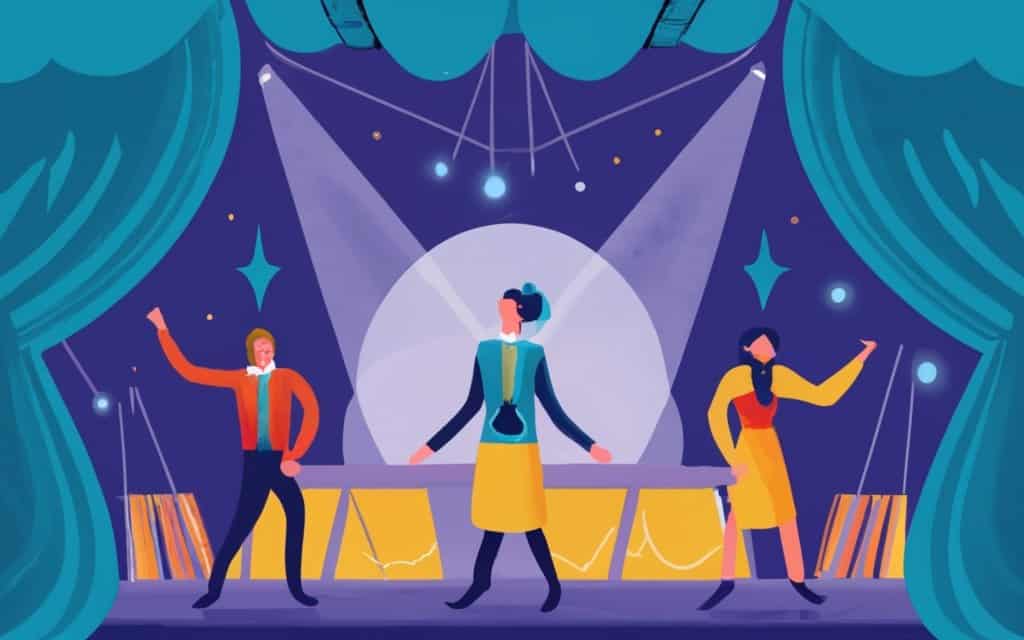The Art of Stagecraft

Performing magic is much more than executing tricks flawlessly. The real magic lies in your ability to captivate the audience, and this is where stagecraft for performing shows comes into play.
Defining Stagecraft
Stagecraft is the art of creating a memorable and engaging performance environment. It involves various aspects such as set design, lighting, sound, costume, props, and most importantly, your interaction with the audience. Mastering stagecraft can dramatically improve the quality of your magic shows, creating a lasting impression on your spectators.
In the context of magic, stagecraft also involves the strategic use of misdirection, patter, and timing to create illusions that captivate and mystify the audience. The successful application of stagecraft can turn a simple card trick into a grand spectacle.
The Importance of Stagecraft in Magic Shows
The role of stagecraft in magic shows cannot be overstated. It’s not just about the trick, it’s about how you present it. As a magician, your primary goal is to create an unforgettable experience for your audience. This is achieved not only through stage magic tricks but also by effectively employing stagecraft techniques.
By skillfully managing all the elements of stagecraft, you can control the atmosphere, mood, and pacing of your performance. This can enhance the perceived complexity and impact of your tricks, making your show more entertaining and engaging.
Moreover, stagecraft also plays a crucial role in maintaining the illusion of magic. It helps to divert the audience’s attention, making your tricks seem more miraculous and inexplicable.
In the world of magic, the importance of mastering stagecraft for performing shows is well recognized. It’s not just a skill but a necessity for anyone who wishes to leave a lasting impression on their audience. Learn more about how to enhance your performances with our magic show performance tips.
Stagecraft for Performing Shows Tip 1: The Power of Illusion

Illusion plays a critical role in magic shows, captivating audiences and creating a sense of wonder. By mastering stagecraft for performing shows, you can enhance the impact of your illusions and elevate your performances.
Creating Illusions with Stagecraft
In the world of magic, the successful creation of illusions hinges on effective stagecraft. The scenery, lighting, sound, and props all work in synergy to build an immersive environment where illusions can thrive.
One of the fundamental aspects of creating illusions is the art of misdirection. This involves drawing the audience’s attention away from your secretive actions and towards something unrelated. It’s a delicate balance that requires careful planning and execution.
To create a compelling illusion, you need to understand the psychology of your audience. Knowing what they expect to see can help you to manipulate those expectations and create a more impactful illusion. For instance, the audience will naturally follow your gaze, so looking at a particular spot can direct their attention there.
The stagecraft elements can be used to enhance this misdirection. For example, a sudden flash of light or a sound effect can divert the audience’s attention at a critical moment, allowing you to execute your secretive actions without detection.
For more insights on creating illusions, you can read our article on magic tricks for performing shows.
Techniques for Developing Illusions
There are several techniques that you can use to develop and enhance your illusions. Here are a few that you might find helpful:
- Storytelling: Incorporating a narrative into your magic trick can hook the audience’s attention and make the illusion more engaging. It provides context for the trick and can create suspense and anticipation.
- Timing: The timing of your actions and the stagecraft elements is crucial in creating a successful illusion. Practice your timing to ensure that all elements of the illusion work together seamlessly.
- Rehearsal: Rehearsing your illusion in the actual performance setting can help you to identify any potential issues and make necessary adjustments. It gives you a chance to get comfortable with the stagecraft elements and ensure they are working as intended.
- Feedback: Get feedback from others about your illusion. This can give you valuable insights into how the illusion is perceived and where improvements can be made.
| Technique | Description
|
|---|---|
| Storytelling | Incorporating a narrative into your magic trick |
| Timing | Ensuring all elements of the illusion work together seamlessly |
| Rehearsal | Practicing in the performance setting |
| Feedback | Getting insights from others about your illusion |
Honing these skills can significantly enhance the quality of your illusions. For more advanced techniques, check out our tutorial on stage magic tricks.
Stagecraft for Performing Shows Tip 2: Staging and Set Design

The stage is essentially your canvas as a magician. It sets the mood, becomes your playground, and acts as an extension of your performance. A well-arranged stage and thoughtful set design can significantly enhance the audience’s experience and your act’s overall impact.
Choosing the Right Set Design
Selecting the right set design is an integral part of stagecraft for performing shows. It’s crucial that your set design aligns with the theme and style of your magic show. A grand, elaborate set may be suitable for a stage filled with large illusions, while a minimal, clean design could be ideal for more intimate, close-up magic shows.
Consider the following when choosing your set design:
- Theme: Your set should reflect the mood and style of your magic show. If your act includes dark, mysterious stage magic tricks, a gothic-inspired set could work well. On the other hand, a colorful, playful set could be perfect for a family-friendly magic show.
- Functionality: Your set design should facilitate, not hinder, your performance. Ensure there’s enough space to execute your tricks smoothly, and consider how the set can hide props or assist with illusions.
- Audience Experience: Think about your audience’s perspective. Ensure that your set doesn’t obstruct any views and enhances the audience’s immersion in your show.
Setting the Stage for Your Magic Show
Setting the stage for your magic show involves more than just arranging props and backdrops. It’s about creating a space that captivates your audience from the moment they enter the room.
Here are a few tips for setting the stage:
- Lighting: Use lighting to highlight your tricks and create a dramatic effect. For example, spotlighting can draw attention to a specific area on the stage, while colored lights can create various moods.
- Props: Arrange your props in a way that they are easily accessible yet unobtrusive. Remember, clutter can distract your audience and disrupt the flow of your performance.
- Backdrops: The right backdrop can add depth to your stage and enhance your act’s visual appeal. Choose a backdrop that complements your set design and doesn’t steal the focus from your performance.
In the world of magic, your stage and set design can be powerful tools to create an unforgettable experience for your audience. Invest time in planning and setting up your stage to ensure it serves your performance and mesmerizes your audience. For more magic show performance tips, check out our other articles.
Stagecraft for Performing Shows Tip 3: Lighting and Sound

In the realm of stagecraft for performing shows, lighting and sound are two powerful elements that can significantly enhance the impact of your performance. When harnessed effectively, they can add depth and dimension, heighten suspense, and guide the audience’s attention.
The Role of Lighting in Stagecraft
Lighting is a crucial aspect of stagecraft. It’s not just about visibility – it’s about creating mood, directing attention, and enhancing illusions. A well-lit stage can draw the audience in, while strategic spotlighting can highlight the climax of your trick.
Different lighting techniques can also create various moods. Soft, warm lighting can create an intimate atmosphere, while stark, bright lights can add a sense of drama or urgency. Experiment with different colors, intensities, and angles to find what best suits your performance style and the specific tricks you are performing.
Remember, the key is subtlety. Your lighting should complement your tricks, not overshadow them. It should guide the audience’s eyes and enhance the illusion, not reveal the secrets. For more information on how to effectively incorporate lighting into your magic shows, you can explore our article on magic show performance tips.
How Sound Enhances Your Performance
Sound, much like lighting, is an integral part of stagecraft that can greatly amplify the effect of your magic tricks. The right music or sound effect at the right moment can make a trick more compelling and memorable.
Sound can help set the tone for your performance, be it mysterious, playful, or dramatic. It can also serve as an audible misdirection, masking the noise of your movements or drawing attention away at key moments.
Moreover, sound can help build suspense or signal a climax. A crescendo in music can signal that something amazing is about to happen, priming your audience for the big reveal.
When choosing music or sound effects, consider your audience, the setting, and the mood you want to create. The sound should be an extension of your performance, reinforcing the story you’re telling and the emotions you’re trying to evoke.
Remember, the sound should not be overpowering. It should supplement your performance, not distract from it. For more guidance on how to use sound effectively in your magic shows, check out our article on magic tricks for performing shows.
Lighting and sound are just two elements of stagecraft that can help elevate your magic shows. By understanding and mastering these aspects, you can create a more immersive and engaging experience for your audience. After all, a great magic show is not just about the tricks you perform, but also the atmosphere you create.
Stagecraft for Performing Shows Tip 4: Costumes and Props
When it comes to stagecraft for performing shows, the visual elements are just as important as your magic tricks. The right costumes and props can enhance your performance, making it more engaging and memorable for your audience.
Selecting the Perfect Costume
Your costume is a key part of your on-stage persona. It sets the tone for your performance and gives your audience immediate clues about your magic style and character.
When selecting your costume, consider the following factors:
- Theme: Your costume should align with the theme of your magic show. If your tricks have a Victorian-era vibe, a modern outfit may look out of place. Similarly, a formal tuxedo might not suit a show full of comedic, casual magic.
- Functionality: Your costume should allow you to perform your tricks smoothly. If a trick requires dexterity, make sure your costume doesn’t restrict your movements. Similarly, if you need to conceal a prop, your costume should provide a suitable hiding place.
- Comfort: You’ll be wearing your costume for the duration of your show, so make sure it’s comfortable. A costume that’s too tight, too loose, or too hot can distract you from your performance.
- Distinctiveness: Your costume should help you stand out. It’s an extension of your brand as a magician, so choose something that represents you and is memorable for your audience.
Read our article on magic show performance tips for more advice on selecting the perfect costume.
Using Props Effectively in Your Show
Props can add excitement to your show and enhance your magic tricks. Here are some tips for using props effectively in your magic show:
- Choose Relevant Props: Your props should be relevant to your tricks and your show’s theme. For instance, if you’re performing card tricks, your props could include a special deck of cards or a magic wand.
- Use Props to Enhance Your Tricks: Props can make your tricks more visually appealing. For example, colored scarves can add a burst of color to a close-up magic trick.
- Practice with Your Props: Just like your magic tricks, you need to practice using your props. This ensures that you can handle them smoothly during your performance.
- Keep Your Props in Good Condition: Make sure your props are clean and in good working order. A broken or dirty prop can ruin the illusion you’re trying to create.
Remember, your props are tools to enhance your performance. They should complement your magic tricks, not distract from them. Check out our guide on stage magic tricks for ideas on how to incorporate props into your show.
In summary, costumes and props are integral elements of stagecraft for performing shows. They contribute to the overall aesthetic of your show and can enhance your audience’s experience. By selecting the right costume and using props effectively, you can create a magic show that’s truly magical.
Stagecraft for Performing Shows Tip 5: Audience Interaction and Engagement

An integral part of mastering stagecraft for performing shows is understanding how to effectively interact with and engage your audience. This can make the difference between a good magic show and a truly memorable one.
Connecting with Your Audience
As a performer, you need to connect with your audience on an emotional level. This involves understanding their expectations, reading their reactions, and tailoring your performance to resonate with them. It’s not just about performing a series of magic tricks, it’s about creating a shared experience that will leave them amazed and entertained.
One way to connect with your audience is through storytelling. A compelling narrative can add depth to your magic tricks, making them more engaging and memorable. Try to weave a story that relates to the theme of your magic show or the specific tricks you’re performing.
Humor is another powerful tool for connecting with your audience. Jokes and funny anecdotes can help to break the ice, lighten the mood, and make your audience more receptive to your performance.
Techniques for Audience Engagement
While connecting with your audience is crucial, it’s equally important to actively engage them in your performance. Here are some techniques to consider:
- Direct Participation: Invite members of the audience to participate in your magic tricks. This can make them feel like they’re part of the magic, increasing their interest and enjoyment. For example, you can ask them to pick a card for card tricks, or assist in performing a trick.
- Eye Contact: Make regular eye contact with your audience. This can create a sense of connection and make them feel acknowledged and important.
- Body Language: Use expressive body language to convey your emotions and reactions. This can make your performance more dynamic and engaging.
- Question and Answer: Engage your audience in a question and answer session after your performance. This can give them an opportunity to express their thoughts and curiosity, making them feel valued and involved.
| Engagement Techniques | Description
|
|---|---|
| Direct Participation | Invite audience members to participate in your tricks |
| Eye Contact | Establish connection through regular eye contact |
| Body Language | Use expressive movements to enhance your performance |
| Question and Answer | Encourage audience interaction through Q&A sessions |
Remember, the key to successful audience interaction and engagement lies in understanding your audience and adapting your performance style to suit them. By incorporating these techniques into your stagecraft, you can ensure a more engaging and memorable performance. For more tips on delivering an outstanding magic show, check our article on magic show performance tips.
Stagecraft for Performing Shows Tip 6: Mastering Stage Presence
A key aspect of stagecraft for performing shows is the mastery of stage presence. Your ability to command the stage and captivate your audience can turn a good magic show into an unforgettable one.
Enhancing Your Stage Presence
Stage presence is the energy and charisma you project during your performance. It’s what makes your audience feel connected to you and your magic. To enhance your stage presence, consider the following:
- Confidence: Believe in your magic and your ability to captivate the audience. Practice your stage magic tricks until you can perform them flawlessly.
- Energy: Your energy sets the tone for your show. Make sure it’s high, positive, and infectious.
- Body Language: Use your body to express your personality and demonstrate the magic. Make your movements intentional and clear. This article explains seven tips for effective body language on stage.
- Eye Contact: Connect with your audience by maintaining eye contact. This can make your spectators feel seen and involved in the magic.
Tips for Commanding the Stage
Commanding the stage is about taking control and guiding your audience through your performance. Here are some tips to help you do just that:
- Set the Pace: Your show, your rules. Set the pace of your performance to suit your style and the nature of your tricks.
- Engage the Audience: Make your audience a part of the show. Ask for volunteers, respond to reactions, and involve spectators in your tricks.
- Control the Space: Use the entire stage. This can make your performance more dynamic and visually appealing.
- Master Your Tricks: Nothing commands respect like flawless execution. Whether you’re performing close-up magic tricks for shows or card tricks for magic shows, make sure you’ve mastered your material.
- Narrate the Magic: Tell a story with your magic. This can make your show more engaging and memorable.
Remember, stage presence and command are skills that can be developed with practice and experience. It’s part of the art of stagecraft that will truly set your magic shows apart. For additional tips, check out our magic show performance tips.
